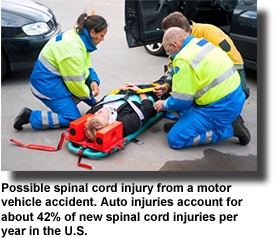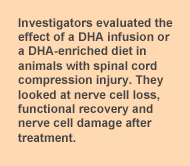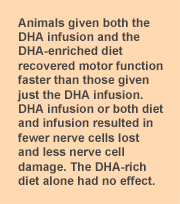DHA After Spinal Cord Injury Linked to Improved Recovery of Motor Function in Mice
 About 12,000 new spinal cord injuries occur every year in the U.S., often with crippling consequences. Most of the injuries occur in men as a result of automobile accidents, falls, violence and sports. Decompression surgery, rehabilitation therapy and pharmacologic agents may ease the damage, but functional recovery remains very limited. More promising therapies may be on the horizon as scientists examine substances that limit the damage to nerve cells and promote cell and functional recovery. A leading candidate in this research is DHA, one of the principal long-chain omega-3 fatty acids. DHA is also a key component of nerve cells.
About 12,000 new spinal cord injuries occur every year in the U.S., often with crippling consequences. Most of the injuries occur in men as a result of automobile accidents, falls, violence and sports. Decompression surgery, rehabilitation therapy and pharmacologic agents may ease the damage, but functional recovery remains very limited. More promising therapies may be on the horizon as scientists examine substances that limit the damage to nerve cells and promote cell and functional recovery. A leading candidate in this research is DHA, one of the principal long-chain omega-3 fatty acids. DHA is also a key component of nerve cells.
Research in animals with brain, spinal cord and nerve damage has demonstrated that DHA, when administered shortly after an injury, reduces the loss of nerve cells, increases the survival of neurons and improves functional recovery, such as the ability to move a limb or bear weight. It also promotes the growth of new nerve cells, improves the connections among them and reduces the inflammation that accompanies the injury. In fact, damage from inflammation contributes substantially to the poor outcomes of patients with these injuries.
 Ultimately, the goal of this type of research is to identify therapies and treatments that halt the damage, repair tissues, stimulate new nerve growth and promote the restoration of limb function in humans. Leading to that are studies in animals with various types of brain and spinal cord injuries. Moreover, different animals respond in different ways to such injuries, so studies in several species are required prior to studies in humans. This report builds on previous work in rats with new experiments in mice, which respond differently to spinal cord compression injury. This type of study might also provide detailed insights into how DHA contributes to recovery from spinal cord injury.
Ultimately, the goal of this type of research is to identify therapies and treatments that halt the damage, repair tissues, stimulate new nerve growth and promote the restoration of limb function in humans. Leading to that are studies in animals with various types of brain and spinal cord injuries. Moreover, different animals respond in different ways to such injuries, so studies in several species are required prior to studies in humans. This report builds on previous work in rats with new experiments in mice, which respond differently to spinal cord compression injury. This type of study might also provide detailed insights into how DHA contributes to recovery from spinal cord injury.
Investigators at Queen Mary University, London, examined the effect of treating injured animals with different amounts of DHA provided by infusion immediately following the injury or in the diet. After spinal cord compression injury, the animals continued to lose nerve cells 1 and 4 weeks later. Further, the neurons sustained substantial damage to their axons, the cell projections that communicate with other cells. Injury to the axons prevents nerve cell communication, tissue repair and limb function. The injured animals also experienced severe, but not total paralysis, with only partial recovery after 4 weeks without treatment.
What effect did DHA treatment have? Infusion with the highest level of DHA evaluated gave the best results. The animals improved their motor and movement activity significantly as early as 4 days after injury. Scores for their motor activity continued to improve over the 4-week period, with the DHA-treated animals scoring more than one-third higher than the control animals not given DHA.
 Animals given both the DHA infusion and the DHA-enriched diet recovered motor function faster than those given just the DHA infusion. However, the difference in scores did not reach statistical significance, possibly because of the variability in scores and the relatively small differences between the two DHA-treated groups. The investigators noted that in spite of the lack of significant differences, animals given both the DHA-rich diet and the DHA infusion fared better than the DHA-infused animals. Providing DHA only in the diet without the infusion did not improve the animals’ recovery.
Animals given both the DHA infusion and the DHA-enriched diet recovered motor function faster than those given just the DHA infusion. However, the difference in scores did not reach statistical significance, possibly because of the variability in scores and the relatively small differences between the two DHA-treated groups. The investigators noted that in spite of the lack of significant differences, animals given both the DHA-rich diet and the DHA infusion fared better than the DHA-infused animals. Providing DHA only in the diet without the infusion did not improve the animals’ recovery.
In addition to the benefits of DHA on functional recovery, the investigators reported that DHA infusion plus the DHA-enriched diet was associated with fewer nerve cells lost and less damage to the nerve cell axons. The investigators noted that provision of DHA immediately following the injury was essential for protecting the nerve cells and for functional improvement. A DHA-enriched diet alone was insufficient to achieve these results. Pretreatment of the animals with DHA prior to the injury was not evaluated in this study, but others have reported that pretreatment with DHA was associated with fewer functional losses and improved cell survival.
These studies add to the growing evidence that DHA provided to injured animals immediately after traumatic injury is associated with less loss of nerve cells, less damage to the structure of the cells and improved functional recovery. The findings strengthen the suggestion that DHA might have similar effects in humans with spinal cord injuries.
Addendum: After the newsletter was written, the editor obtained a prepublication case report of an adolescent who suffered severe traumatic brain damage in an automobile accident. Eleven days after the accident, high doses of fish oil were added to the patient’s tube feeding. Fish oil was continued for over one year. The patient regained consciousness, was discharged home 4 months after the accident and has continued to gain cognitive and motor function. He now walks with a cane and continues with physical therapy, but has speech and balance difficulties related to his injury. Initially, he was not expected to survive.

